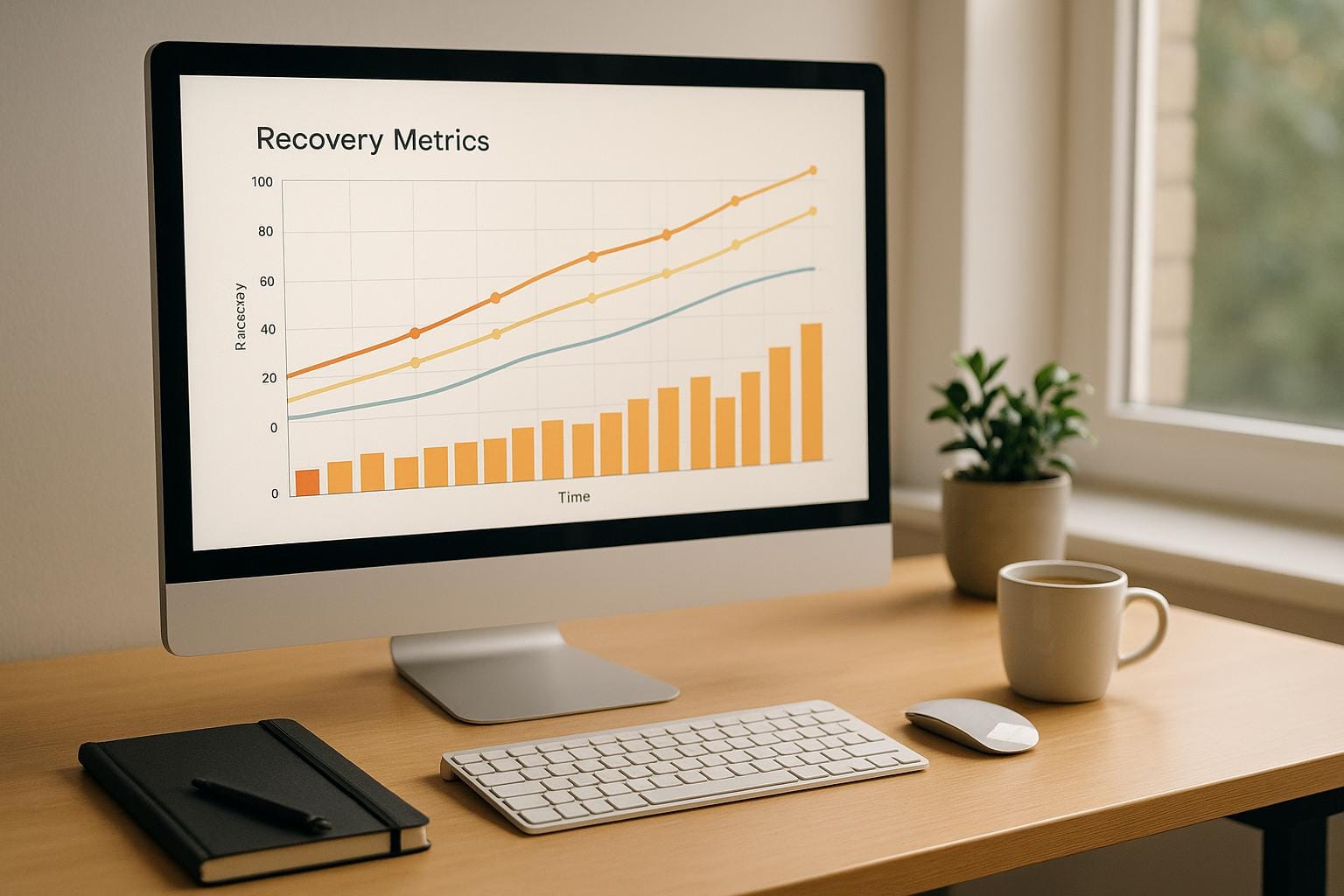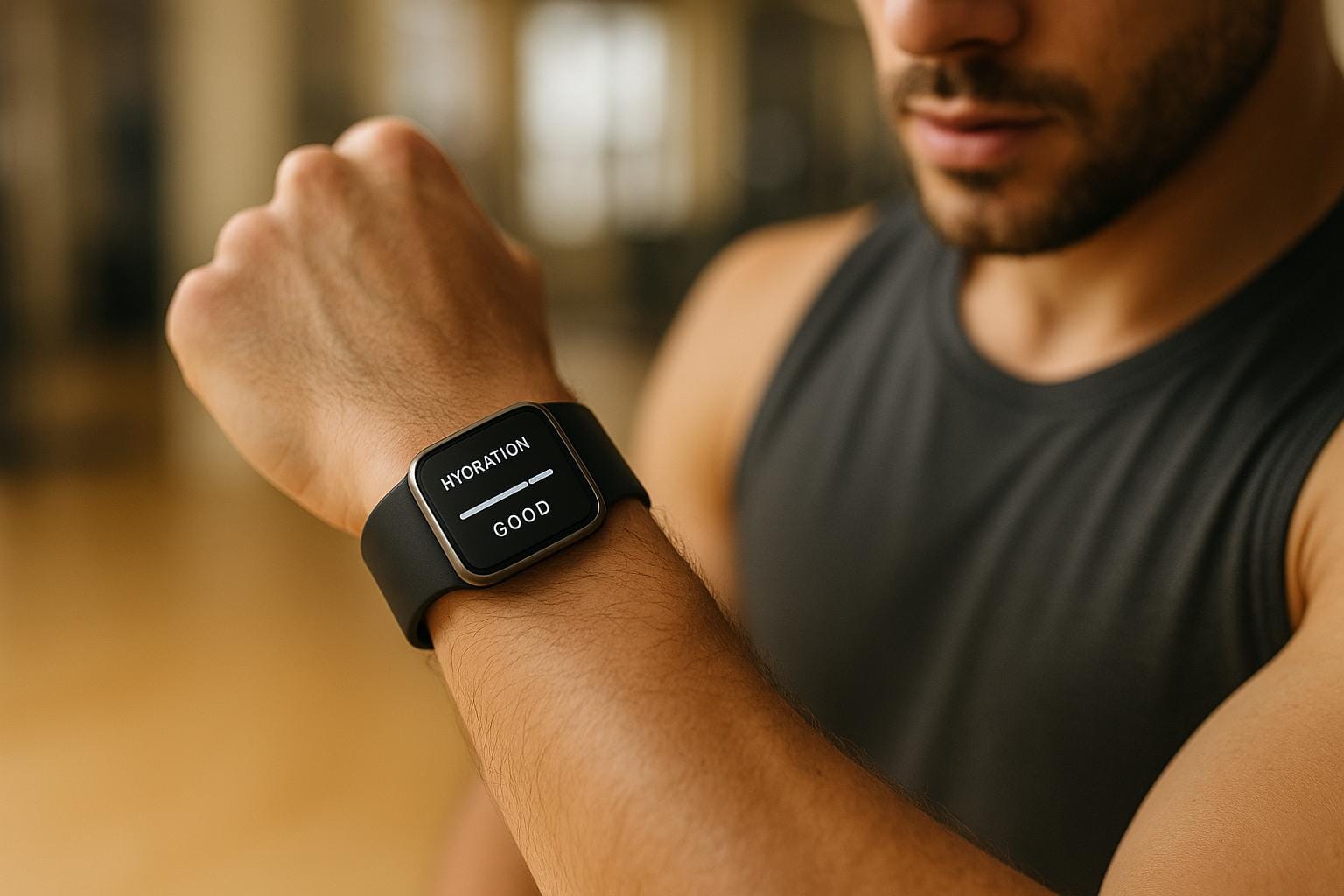Tracking your recovery metrics is the key to smarter training and avoiding burnout. Using charts, you can visualize patterns and trends in your recovery to make better decisions about rest and performance. Here's what you need to know:
- What to Track: Key metrics include Heart Rate Variability (HRV), sleep quality, resting heart rate, perceived fatigue, and mood.
- Why Use Charts: Charts help you spot trends, like dips in HRV or poor sleep after intense workouts, and communicate these insights effectively with coaches or healthcare providers.
- How to Start: Gather consistent data (e.g., HRV in the morning, sleep duration), use line charts for trends, and customize visuals for clarity with labels, colors, and annotations.
- Actionable Insights: Use your data to adjust training intensity, optimize rest periods, and improve habits like sleep, nutrition, and hydration.
Rest and Recovery in Endurance Cycling and Running Training Using TrainingPeaks and Strava Metrics

Key Recovery Metrics to Track
When it comes to recovery, focusing on a few targeted metrics can provide valuable insights. Let’s dive into three core categories of recovery metrics that are ideal for tracking through charts.
Heart Rate Recovery (HRR) and Heart Rate Variability (HRV)
Your heart holds essential clues about your recovery. Two key metrics - Heart Rate Recovery and Heart Rate Variability - offer a deeper understanding of how well your body is bouncing back.
Heart Rate Recovery (HRR) measures how quickly your heart rate drops after intense exercise. It reflects how effectively your autonomic nervous system transitions from a heightened state of exertion to a calmer, recovery-focused mode. To calculate your HRR, note your heart rate immediately after stopping exercise and then measure it again one minute later. The difference between these two readings is your HRR score.
According to a study in the New England Journal of Medicine, the median HRR is 17 beats per minute, with a typical range of 12 to 23 bpm.
Heart Rate Variability (HRV), on the other hand, examines the slight variations in time between each heartbeat. While your heart might feel like it beats steadily, healthy hearts actually have minor fluctuations, which indicate a responsive and balanced nervous system.
"Heart rate variability is a measure of stress and recovery within the body, from a physiological standpoint."
- Vincent Luppino, PT, DPT, OCS, physical therapist at HSS Paramus
HRV varies with age and fitness level. For example, someone in their 20s typically has an HRV range of 55 to 105 milliseconds, while those in their 60s might see 25 to 45 milliseconds. Instead of comparing your HRV to others, focus on your personal trends over time.
"It is better to follow your own individual trend of HRV over time to help you make decisions on any given day."
- Vincent Luppino, PT, DPT, OCS, physical therapist at HSS Paramus
For the most accurate readings, measure HRV first thing in the morning. Pay attention to 7-day and long-term trends, as they provide a clearer picture than daily fluctuations. A stable or slightly increasing HRV suggests good recovery, while sudden drops may indicate stress, illness, or poor sleep. Visualizing these patterns over time can reveal critical insights. Now, let’s explore how sleep metrics complete the recovery equation.
Sleep Quality and Duration
Sleep is much more than rest - it’s when your body does the heavy lifting of recovery. During deep sleep, growth hormones repair muscles and tissues, making sleep quality and duration essential for anyone serious about recovery.
Surveys show worrying trends among athletes: nearly 50% of elite athletes sleep less than the recommended 7 to 9 hours per night, and 28% of student-athletes report sleep issues. The impact is real - athletes who sleep less than 7 to 8 hours face a much higher risk of injury.
In fact, adolescent athletes who sleep fewer than 8 hours are 1.7 times more likely to get injured compared to those who hit the 8-hour mark.
When tracking sleep, focus on two main metrics: total sleep duration and sleep efficiency percentage. Sleep duration is straightforward - aim for 8 to 10 hours depending on your training needs. Sleep efficiency measures how much of your time in bed is spent actually sleeping, with higher percentages reflecting better quality rest.
Modern sleep trackers can also provide sleep stage distribution, breaking down time spent in light sleep, deep sleep, and REM sleep. Deep sleep is crucial for physical recovery, while REM sleep supports mental processes like memory and learning. Tracking and visualizing these metrics over time can help you fine-tune your recovery. Next, let’s look at how training load and fatigue fit into the picture.
Training Load and Fatigue Levels
Balancing how hard you train with how tired you feel is key to optimizing recovery. Training load measures the overall stress you’re placing on your body, while fatigue levels indicate how well you’re adapting to that stress.
Training load can be tracked using metrics like total training time, intensity zones, or a combined weekly stress score that factors in heart rate and perceived effort. This provides an objective picture of how much strain your body is under.
Fatigue levels, however, are often based on subjective measures. Start by rating your morning fatigue on a 1–10 scale, considering muscle soreness, energy levels, and motivation. While this might feel less precise than heart rate data, studies show that perceived exertion aligns closely with physiological stress markers.
"Measuring HRV can be a simple and effective tool in assessing whether one is ready for the next training session… It should not be the sole basis for training decisions, but it can be a reliable indicator of balance and adaptation."
- Dr. Hans Kristian Stadheim, Norwegian School of Sport Sciences
Charting training load against fatigue levels over time can reveal useful patterns. Ideally, fatigue should rise and fall in sync with training load, with recovery periods allowing fatigue to return to baseline. Watch out for warning signs like persistent fatigue despite reduced training or sudden spikes in fatigue unrelated to workload.
Track both acute fatigue (day-to-day variations) and chronic fatigue (long-term trends). While acute fatigue naturally changes with your training schedule, upward trends in chronic fatigue could indicate overtraining or inadequate recovery. Visualizing these patterns can help you adjust your approach to training and recovery.
This article is for informational purposes only and is not intended as medical advice. Please consult a healthcare professional before starting any new fitness or wellness routine.
Step-by-Step Guide to Creating Recovery Charts
Building on the recovery metrics discussed earlier, this guide will show you how to turn raw data into easy-to-read charts that can help you make better training decisions. By focusing on data collection, chart selection, and presentation, you’ll be able to create charts that provide clear insights into your recovery.
Gathering and Organizing Data
The backbone of any effective recovery chart is clean, well-structured data. Start by collecting information from reliable sources like fitness trackers, sleep monitors, training apps, or even manual logs. Once you’ve gathered your data, organizing it properly is crucial to avoid common mistakes.
Be consistent with data collection. Whether you’re tracking HRV readings from a smartwatch, sleep scores from a fitness tracker, or manually noting fatigue levels, pick specific times for recording data. For instance, morning measurements are often the most reliable for HRV and resting heart rate, while sleep data is naturally recorded overnight.
Handle dates carefully. Date errors are a frequent issue when working with data. To avoid confusion, you can either:
- Split dates into separate columns for year, month, and day. For example, instead of using “03/15/2025,” break it down into three columns: Year (2025), Month (03), and Day (15).
- Standardize your date format as YYYYMMDDhhmmss. This is especially useful if you’re tracking multiple daily measurements or need precise timestamps.
If you’re using an iPhone, you can export health data from the Health app in XML format for easier processing.
Choosing the Right Chart Type
Selecting the right chart type is key to making your data understandable. For recovery metrics like HRV, sleep duration, or fatigue levels, line charts are often the best choice. They’re great for visualizing trends over time, which is more important than focusing on single data points.
For example, HRV trends can be effectively tracked using line charts. While a healthy HRV range typically falls between 60 and 100 milliseconds, it’s more important to monitor how your values change over time rather than comparing them to general benchmarks. Keep in mind that HRV tends to decrease with age, and men often have slightly higher values than women.
Customizing Charts for Clarity
A good chart should make insights immediately clear, while a poorly designed one can make patterns harder to spot. The goal is to keep your charts simple yet informative.
- Start with a clean design. Avoid clutter by removing unnecessary gridlines, borders, or decorative elements that don’t add value. A clean layout can improve how quickly and accurately users understand the data by up to 50%.
- Use color intentionally. Highlight key data points with a color-coding system. For example, use green for good recovery days, yellow for moderate concern, and red for poor recovery. Research shows that users are 60% more likely to engage with charts that use distinct font sizes and colors.
- Label everything clearly. Replace generic labels like “Metric 1” with descriptive terms such as “Morning HRV (ms)” or “Sleep Efficiency (%)”. Include units of measurement on your axis labels to avoid confusion.
- Add reference lines. If your baseline HRV is 65ms, include a horizontal line at that level. This makes it easier to notice when your values deviate from the norm.
- Include context. Annotations for events like illness, travel, or major training changes can explain unusual data points and make your charts more meaningful.
Make charts user-friendly. If you plan to review them on a mobile device, ensure the text and data points are easy to read on smaller screens. Also, consider accessibility by using high-contrast colors and avoiding reliance on color alone to differentiate data series.
By focusing on these elements, you’ll create charts that are not only informative but also practical for guiding your recovery strategy. Up next, we’ll dive into how to interpret these charts effectively.
This article is for informational purposes only and is not intended as medical advice. Always consult a healthcare professional before starting any new fitness or wellness routine.
How to Read Recovery Charts for Progress Tracking
Got your recovery charts ready? Now it's time to figure out what they're really telling you. These charts are more than just numbers - they’re a window into your body’s patterns and trends over time. The key is to look beyond individual data points and focus on the bigger picture.
Identifying Long-Term Patterns and Anomalies
When analyzing your recovery charts, think long-term. Instead of fixating on daily fluctuations, pay attention to patterns that develop over weeks or months. These trends are where the real insights about your fitness progress lie.
Spot shifts in your baseline. A steady or improving baseline is a positive sign. For instance, with heart rate variability (HRV), consistent or gradually rising averages indicate good recovery. Similarly, a slow, steady decrease in resting heart rate often points to improved cardiovascular fitness.
Be alert to signs of overtraining. If your resting heart rate starts climbing for several days in a row, it could mean you’re pushing too hard. This is a good time to reassess your training load and stress levels.
"Overtraining happens when an athlete stops making progress and even starts to lose fitness by constantly exposing their body to a training load without sufficient recovery." - Jakub Novak, Head Coach at ProCyclingCoaching
Account for external influences. Life happens, and your recovery data will reflect that. Stress from work, travel, illness, or disrupted sleep schedules can cause noticeable dips or spikes in your metrics. Keeping track of these events alongside your data helps you see how they impact your recovery.
Track improvements in sleep quality. Research shows that monitoring sleep patterns can improve sleep quality by up to 20%. Look for trends in how long you sleep and how efficient your sleep is. Better sleep often goes hand in hand with improved recovery.
Recognize plateaus. Sometimes, despite your best efforts, your recovery metrics may level off. If this happens alongside a drop in performance, it might be time to rethink your training strategy.
These insights can help you fine-tune your approach, which we’ll dive into next.
Using Data to Adjust Training
Once you’ve identified patterns in your recovery charts, use them to guide your training decisions. Your data isn’t just numbers - it’s a tool to help you train smarter.
Adjust intensity based on HRV trends. If your HRV is consistently low or trending downward, it’s a sign to ease up. Swap intense workouts for lighter recovery sessions or take a rest day until your HRV bounces back.
Use heart rate recovery as a fitness gauge. A healthy recovery rate means your heart slows down by 30–50 beats per minute within the first minute after exercise. Elite athletes often see drops of 60+ beats per minute. If your recovery rate improves, it’s a green light to gradually increase training intensity. On the flip side, a drop of less than 20 beats per minute might signal room for improvement.
Track weekly training load. Pay attention to how your recovery metrics respond to your training regimen. If high-volume weeks consistently lower your recovery scores, it might be time to add more rest days or dial down the intensity.
Plan tough workouts wisely. Your recovery patterns can tell you when your body is ready for hard sessions. Some people recover fully in 24 hours, while others might need 48–72 hours. Use this information to schedule your most demanding workouts when your body is at its best.
Take extra rest when recovery metrics align poorly. Studies link data-driven adjustments to a 64% higher success rate in achieving fitness goals. If your charts show multiple red flags - like a rising resting heart rate, low HRV, and poor sleep - it’s time to hit pause and recover.
Think of your recovery data as a conversation with your body. While the numbers provide objective insights, combining them with your personal experience will help you make the smartest decisions for your fitness journey.
This article is for informational purposes only and is not intended as medical advice. Please consult a healthcare professional before starting any new fitness or wellness routine.
Using Chart Data to Improve Recovery Strategies
Recovery charts can guide you in making targeted adjustments to your routine, moving away from generic, one-size-fits-all plans.
Adjusting Training and Rest Periods
Your recovery metrics, like heart rate variability (HRV), offer valuable insights into how much stress your body can handle. For instance, a high HRV suggests you're ready for intense workouts, while a low HRV indicates it's time to dial down the intensity. Adjusting the duration and intensity of your workouts based on HRV can help you train more effectively and avoid burnout.
When signs of fatigue appear in your data, consider maintaining your workout duration but lowering the intensity until your recovery improves. For high-intensity training, scheduling rest days every 7 to 10 days is crucial. Recovery charts can help you pinpoint the best timing for these breaks. Research shows that overtraining syndrome affects about 60% of elite athletes and 30% of non-elite endurance athletes.
Tracking metrics such as soreness, mood, fatigue, and sleep at key points during the day - like in the morning, mid-afternoon, and before bed - can give you a clearer picture of your recovery needs.
"No one can function without getting adequate recovery. It can be almost as important as the actual training you're putting in, because if you're not recovering from training, you're not getting a boost from it." - Jessica Yeaton, Physical Therapist at UCHealth SportsMed Clinic
Creating a recovery dashboard that consolidates all your data into one view can make it easier to identify patterns and connections between your health and training metrics. This comprehensive approach allows you to make informed adjustments to both your workouts and lifestyle.
Improving Sleep, Nutrition, and Hydration
Recovery isn't just about workouts - your daily habits play a big role too. Sleep, nutrition, and hydration are key areas to focus on to enhance your recovery.
If your Sleep Recovery Index drops below 75, it’s time to reassess your sleep habits. A score above 75 indicates your body is effectively recharging, but if you're not getting enough deep sleep, tweaking your bedtime routine or adjusting your sleep environment can help.
What you eat and when you eat also matter. For example, studies show that eating more protein in the evening can reduce the time it takes to fall asleep, while higher magnesium and calcium intake may also improve sleep onset. On the other hand, consuming too many carbohydrates during the day has been linked to poorer sleep efficiency and longer periods of wakefulness after falling asleep.
Hydration is another critical factor. Monitoring your urine color is a simple way to keep track of your hydration levels.
Stress can significantly impact recovery as well. Persistent low HRV readings may indicate the need for stress-management techniques like mindfulness or yoga to improve overall recovery.
Sleep quality is especially important for athletes. Some elite athletes may need as much as 10 to 12 hours of sleep each night to perform at their best. If your data shows poor sleep quality, consider reducing screen time before bed, creating a darker sleep environment, or trying relaxation techniques like deep breathing.
"Athletes who sleep more and sleep better perform better, both in the short and the long term. This can mean getting anywhere from 10 to 12 hours of sleep each night." - Amy Bender, PhD, Expert in Sleep and Performance
Pay attention to how substances like caffeine or alcohol affect your sleep. This can help you make smarter decisions about when and how much to consume. Recovery tools like foam rolling, stretching, or other relaxation techniques before bed can also promote better sleep and help your body unwind. Use your recovery metrics to evaluate how these interventions impact your next-day performance and adjust accordingly.
The goal isn’t to achieve perfection but to make steady progress. Use the insights from your recovery charts to create a recovery plan that adapts to your training and lifestyle over time.
This article is for informational purposes only and is not intended as medical advice. Please consult a healthcare professional before starting any new fitness or wellness routine.
Conclusion: The Benefits of Tracking Recovery Metrics
Using recovery charts to monitor your progress transforms vague assumptions into a solid, data-driven approach that delivers measurable outcomes. Regular tracking allows you to uncover patterns, recognize strengths, and pinpoint areas that need attention with impressive precision.
Consistent monitoring of recovery metrics not only helps prevent injuries but also supports peak performance. By identifying early warning signs, you can address potential issues before they hinder your progress.
Charts also serve as a motivational tool. They don't just reflect hope that your recovery strategies are effective - they provide concrete evidence of improvement. This data gives you the confidence to fine-tune your training and recovery routines to align with your personal needs. Whether it’s adjusting your rest days or improving sleep habits, these insights help you optimize your overall fitness .
The real power of recovery tracking lies in how you use the data. Analyzing trends and acting on them is what makes your charts truly valuable. As Dr. Karin VanBaak from CU Sports Medicine & Performance Center explains:
"In order to see gains in fitness, in order for the body to keep doing what you want it to do, you have to give it enough rest to repair itself."
- Dr. Karin VanBaak
To make tracking a sustainable habit, consider keeping a training log, monitoring your daily metrics, and using the trends you uncover to refine your recovery strategy. By visualizing your progress, you transform raw data into actionable insights that guide smarter decisions. These habits create a foundation for long-term fitness success.
This article is for informational purposes only and is not intended as medical advice. Please consult a healthcare professional before starting any new fitness or wellness routine.
FAQs
How can I use heart rate variability (HRV) to adjust my workout intensity effectively?
To incorporate heart rate variability (HRV) into your workout routine, start by measuring it daily at the same time to build a consistent baseline. When your HRV is at or above this baseline, it's usually a sign that your body has recovered well and is ready for more intense training. However, if your HRV dips below the baseline, it could indicate fatigue or stress, suggesting you might benefit from lowering your workout intensity or even taking a rest day.
Regularly monitoring HRV trends allows you to adjust your training schedule, improve recovery, and avoid overtraining, ultimately supporting better performance and steady fitness progress.
How can I accurately track recovery metrics for fitness progress?
To get a precise handle on your recovery metrics, start with reliable, well-calibrated fitness monitoring devices. These tools are essential for tracking key indicators like heart rate variability (HRV), sleep quality, and activity levels. But here’s the trick: consistency matters. Try to collect your data at the same time each day to account for natural fluctuations.
For a more complete view of your recovery, don’t just focus on one metric. Combining data - like monitoring both your sleep patterns and HRV - offers deeper insights into how you're progressing. And don’t overlook the basics: ensure your devices fit properly and are used as directed to reduce the chances of inaccurate readings.
With these steps, you’ll have a clearer and more reliable picture of your recovery and overall fitness progress.
What are the best ways to improve sleep for better recovery?
To improve your sleep and aid recovery, stick to a regular sleep schedule - yes, even on weekends. Try to avoid caffeine, alcohol, and heavy meals for at least three hours before bed, and give yourself a break from screens for two hours before sleeping. Getting regular exercise, particularly earlier in the day, can also help regulate your sleep by promoting the release of natural sleep hormones.
Establish a relaxing bedtime routine, like doing some light yoga or unwinding with soothing music. Pay attention to your sleep environment: keep it dark, quiet, and cool (around 65°F) to create the perfect setting for restful sleep. These small changes can make a big difference in how well you sleep, how quickly you recover, and how refreshed you feel each day.












